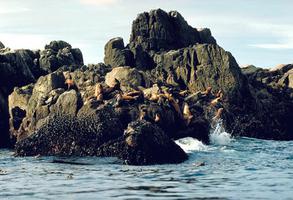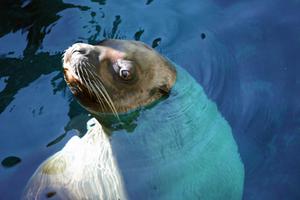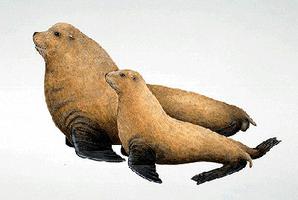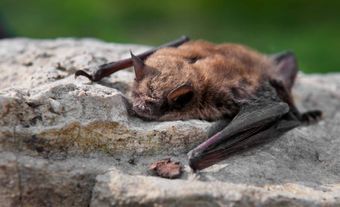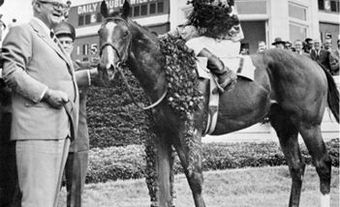Sea Lion
The northern sea lion, also called the Steller sea lion (Eumetopias jubatus), is the largest of the eared SEALS. Steller sea lions range from southern California, around the Pacific rim to northern Japan, but most of the world population breeds between the central Gulf of Alaska and the western Aleutian Islands in Alaska. There are three major breeding sites, or rookeries, in British Columbia.
Stellers have tawny brown fur and buff-coloured upper parts. Males, called bulls, weigh as much as 1000 kg and have massive necks and foreparts. Females, called cows, are smaller at 350 kg and are slender and streamlined. Stellers have large hairless flippers, and use their front flippers for propulsion. The hind flippers are turned forward on land and permit the animal to move at a hobbling run. Despite their ungainly appearance on land, sea lions are powerful and graceful swimmers.
Steller sea lions appear to prefer the coastal shelf region within 45 km of shore, although they can be found over 100 km from shore in waters over 2000 m deep. Stellers do not undertake extensive migrations like some other seals and sea lions. However, males may disperse further north than females, and tagged subadults have been sighted up to 1500 km from where they were marked.
Genetic analyses indicate there are 2 separate populations of Steller sea lions. The first ranges from California to southeast Alaska (to 144° w longitude), and includes the 3 rookeries in BC. This population has been increasing since the early 1970s. The second population ranges from central Alaska to Russia and Japan. It has undergone a major population decline since the mid-1970s and was declared an endangered species in the United States in 1997. The reasons for this population decline are unknown, but many researchers suspect poor nutrition is at fault.
Reproduction and Development
Maximum life expectancy is about 18 years for males and 30 years for females. However, fewer than 5% of females live to age 20. Females produce their first pup between the ages of 3 and 9 years. Mature males begin to breed between the ages of 8 and 10 years.
Steller sea lions give birth at rookeries where large males hold territories and fight off other bulls for the right to breed with one or more females. They have a polygamous breeding system. Males begin to come ashore at rookeries in mid-May, and will remain on land until mid-July without eating or drinking. Males hold territories for an average of 2 years. The females arrive shortly after the males and give birth to a single pup within 3 days of being on land. The females usually mate about 2 weeks after pupping. Adults and dependent young tend to concentrate on rookery sites until October, dispersing to non-pupping sites (called haulouts) for the remainder of the year.
The gestation period is about 50 weeks, but the fetus does not begin to grow until the blastocyst is implanted in late September or early October. Pups weigh about 23 kg at birth, but male pups are usually heavier than female pups. They are born from late May to early July, with the peak of pupping occurring in June. Females tend to stay with their pups for the first 5-13 days after birth, then go to sea to feed. Feeding trips generally last for less than 24 hours and occur every 1-3 days. Pups generally nurse for a year and may stay with their mother for up to 3 years. There is considerable uncertainty about when sea lion pups are weaned.
Habitat and Diet
Not all sea lions return to rookeries each summer. About 45% of the population use haulouts during summer, and all use the haulouts during the remainder of the year. Haulouts and rookeries are typically on remote and exposed rocks and islands and are generally believed to be in close proximity to food resources.
Sea lions may feed close to shore or may travel (150 km or more) out to sea. Stomach contents and prey remains found in sea lion feces (such as eye lenses, bones and bills) indicate that Steller sea lions eat a wide range of species. Some of the more frequently found prey include pollock, cod, octopus, squid, salmon, herring, sand lance, capelin, flatfish, rockfish and mackerel. Steller sea lion bulls have even been known to eat the occasional harbour seal pup. Most fish are swallowed whole. There are distinct regional and seasonal differences in the diversity and types of prey consumed
Sea lions were once hunted for their blubber and hides and were killed in large numbers because fishermen thought the sea lions were competing with them. Today, there is very little sea lion hunting and the Steller sea lion is protected in Canada and the United States..

 Share on Facebook
Share on Facebook Share on X
Share on X Share by Email
Share by Email Share on Google Classroom
Share on Google Classroom

